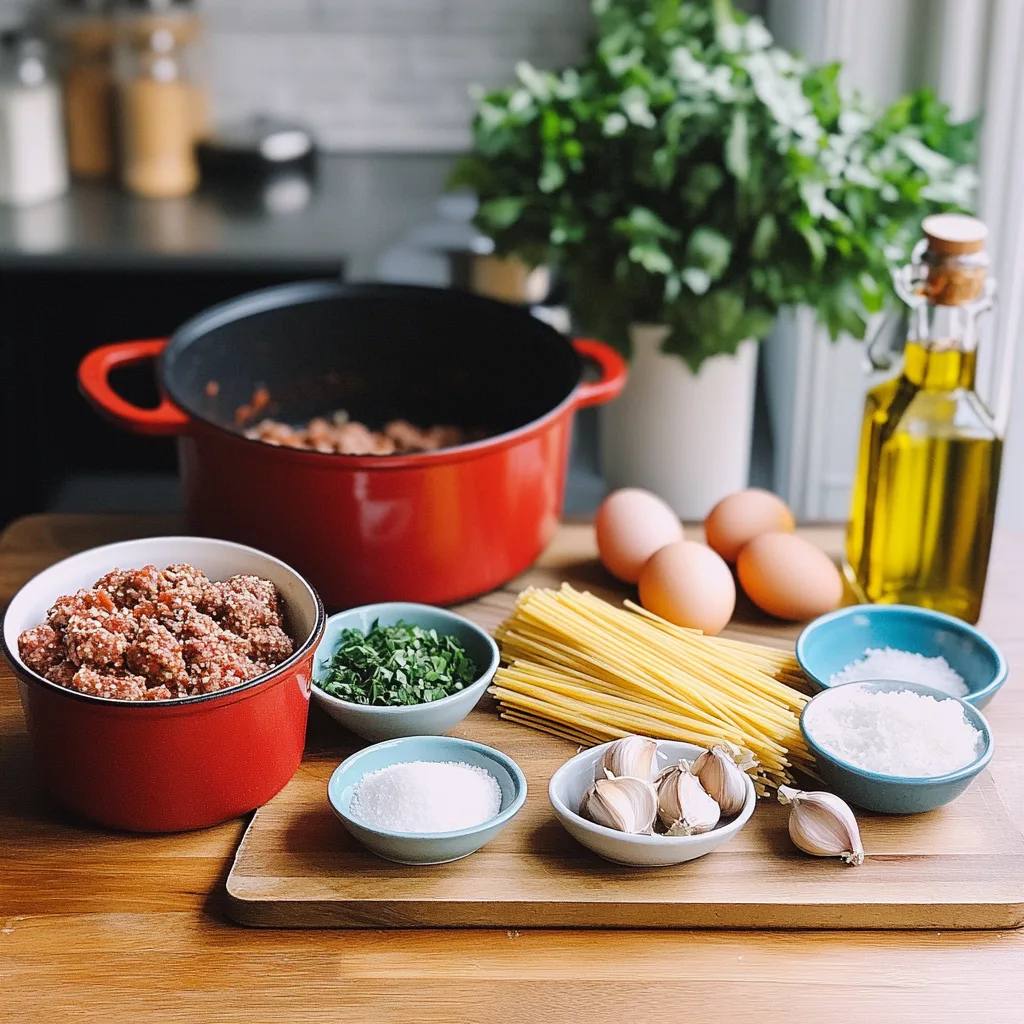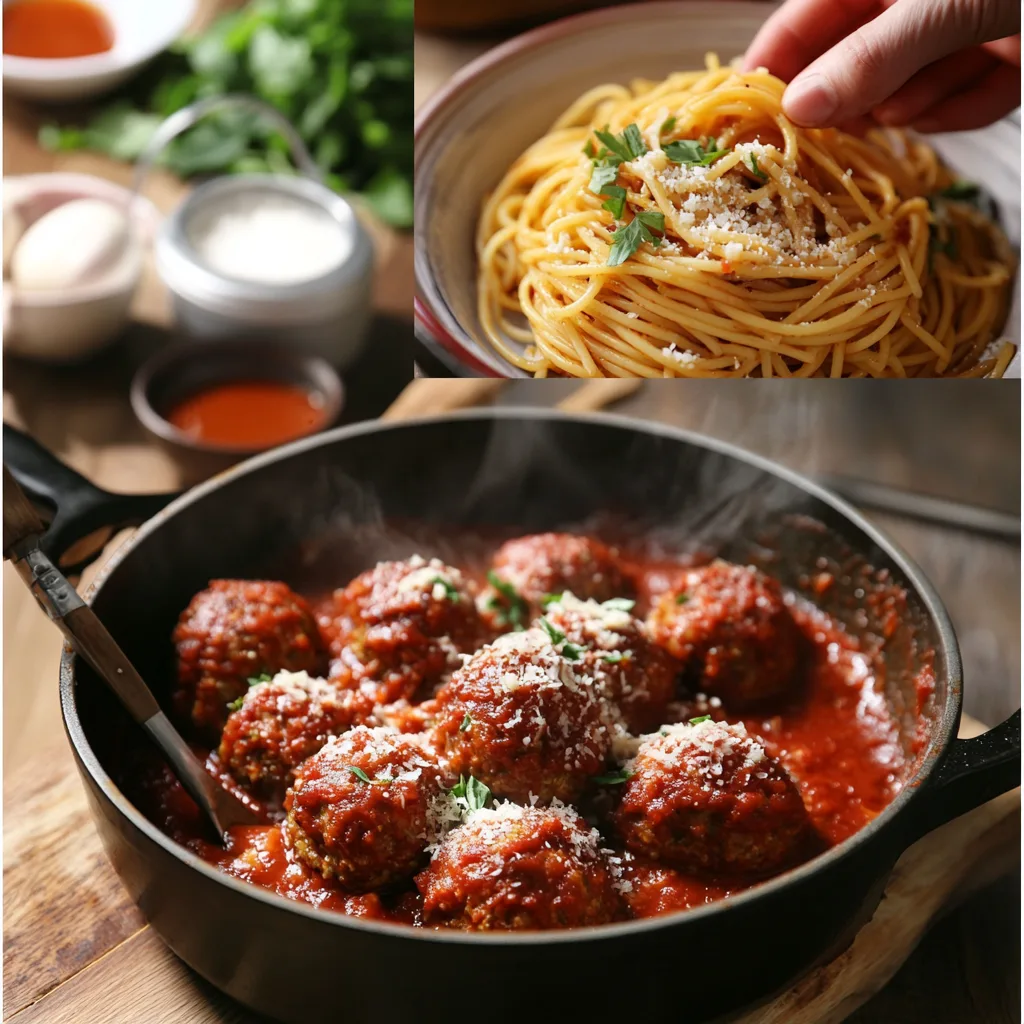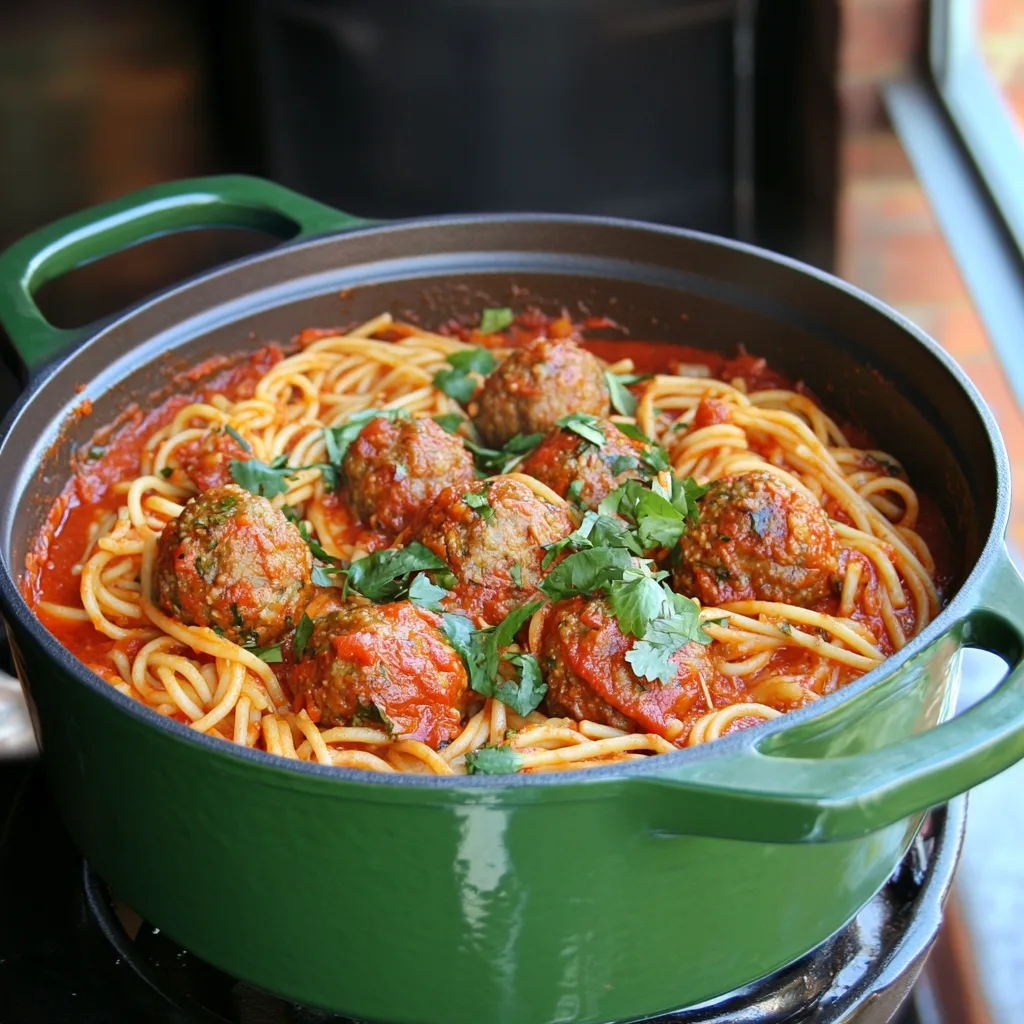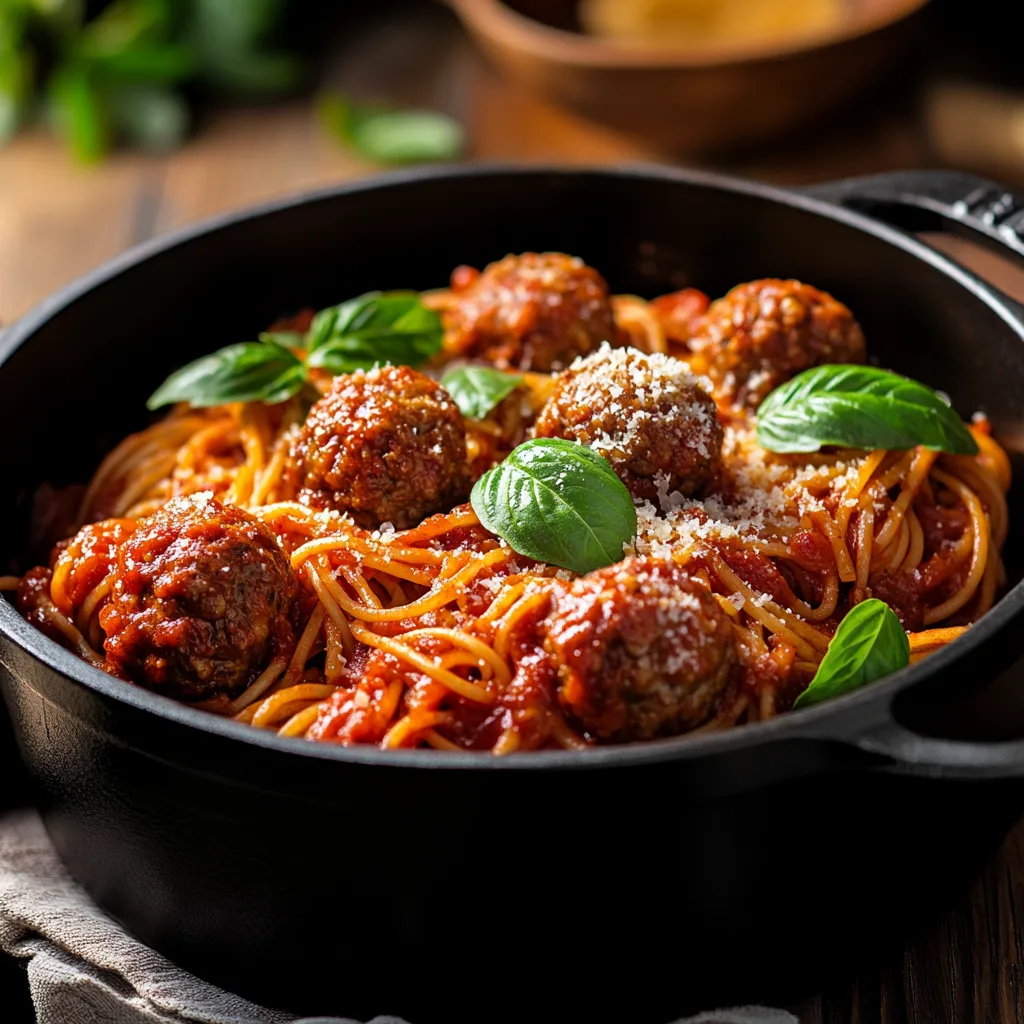There’s something magical about spaghetti and meatballs in a Dutch oven. This one-pot wonder brings together tender meatballs, rich marinara sauce, and perfectly cooked spaghetti in a single dish. It’s a favorite for family dinners, gatherings, or even meal prep because it’s hearty, flavorful, and surprisingly easy to make. Using a Dutch oven simplifies the process, locks in flavors, and creates a meal that feels both rustic and special. Let’s dive in and uncover why this dish is a game-changer.
Why Make Spaghetti and Meatballs in a Dutch Oven?
The Benefits of Cooking in a Dutch Oven
A Dutch oven is a kitchen must-have for dishes like spaghetti and meatballs. Its heavy-duty construction ensures even cooking, which is essential when browning meatballs and simmering sauces. The lid traps in steam, keeping your sauce rich and your meatballs tender. Plus, it’s perfect for one-pot recipes, saving you from washing multiple pans later.
This versatile pot works on the stovetop and in the oven, making it ideal for slow-cooked meals. Whether you’re browning, simmering, or baking, the Dutch oven is your all-in-one solution.
Why Spaghetti and Meatballs Is a Perfect One-Pot Dish
Let’s face it: cooking can sometimes feel overwhelming, especially when it leaves you with a pile of dishes. That’s where one-pot spaghetti and meatballs comes in. By combining the browning, simmering, and pasta cooking steps into a single pot, this recipe keeps things simple without sacrificing flavor.
Cooking the spaghetti directly in the sauce means the pasta absorbs all the savory goodness, making every bite rich and satisfying. It’s a practical and delicious way to bring comfort food to the table with minimal effort.
Ingredients and Preparation
Essential Ingredients for Dutch Oven Spaghetti and Meatballs
Creating spaghetti and meatballs in a Dutch oven calls for simple, high-quality ingredients. Each one brings flavor and depth to this classic dish, making it a true comfort food. Below is everything you’ll need:
Meatballs:
- Ground Meat: A mix of ground beef and pork is ideal for juicy, tender meatballs. For a leaner option, turkey or chicken works beautifully.
- Breadcrumbs: These provide moisture and structure. Substituting with gluten-free breadcrumbs or almond flour is an excellent alternative.
- Eggs: They act as a binding agent, ensuring the meatballs hold their shape.
- Cheese: Grated Parmesan or Romano cheese adds a rich, nutty flavor.
- Seasonings: A mix of garlic, parsley, oregano, salt, and pepper enhances the taste.
Sauce:
- Tomatoes: Crushed canned tomatoes and tomato paste create a thick, savory base.
- Aromatics: Garlic and onions, finely chopped, are sautéed to infuse the sauce with deep flavor.
- Herbs: Fresh or dried basil, oregano, and thyme bring an authentic Italian taste, while a bay leaf adds subtle depth.
- Sugar: A small pinch balances the acidity of the tomatoes.
- Olive Oil: Used to sauté aromatics and enrich the sauce.
Pasta:
- Spaghetti: Traditional spaghetti pairs perfectly, though linguine or fettuccine also work well.
- Broth or Water: Added to the sauce, it helps cook the pasta directly in the Dutch oven for maximum flavor.

Prepping the Meatballs
Perfect meatballs are the cornerstone of this dish. The steps below help you achieve tender, flavorful results every time:
- Combine the Ingredients:
In a large mixing bowl, add the ground meat, breadcrumbs, eggs, Parmesan, garlic, parsley, and seasonings. Mix gently to avoid overworking the meat. - Shape the Meatballs:
Roll the mixture into evenly sized balls, about 1½ inches in diameter. Consistent sizing ensures the meatballs cook evenly. - Brown the Meatballs:
Heat olive oil in your Dutch oven over medium heat. Add the meatballs in batches, turning occasionally to develop a golden-brown crust. Once done, set them aside.
Making the Marinara Sauce in a Dutch Oven
The marinara sauce is what ties this dish together, and cooking it in the Dutch oven intensifies its flavors.
- Sauté the Aromatics:
Add onions and garlic to the same pot, cooking until they’re soft and fragrant. Use the residual fat from the meatballs for extra flavor. - Incorporate the Tomatoes and Liquid:
Stir in the crushed tomatoes, tomato paste, and broth or water. Mix everything thoroughly to create a smooth, thick sauce. - Season to Taste:
Add basil, oregano, thyme, and a bay leaf to the sauce. Adjust the seasoning with salt and pepper, and sprinkle in a pinch of sugar to balance the acidity. - Return the Meatballs to the Sauce:
Gently place the browned meatballs into the simmering marinara. Cover the pot with its lid and let everything cook for 20–25 minutes. The meatballs will infuse the sauce with their savory juices.
Cooking Spaghetti and Meatballs in a Dutch Oven
Combining Meatballs and Sauce
Once your marinara sauce is simmering and flavorful, it’s time to bring the meatballs back into the pot. This step allows the meatballs to soak up the rich sauce while releasing their juices, which intensifies the overall flavor.
- Add Meatballs Gently:
Place the browned meatballs into the marinara sauce, ensuring they are submerged for even cooking. Be careful not to overcrowd the pot—leave a bit of room for the sauce to bubble and move. - Simmer Slowly:
Cover the Dutch oven with its lid and let the meatballs cook over low heat for about 20–25 minutes. This gentle simmering process keeps the meatballs tender while allowing them to absorb the delicious tomato flavors. Stir occasionally to prevent sticking, but avoid breaking the meatballs. - Check for Doneness:
Use a meat thermometer to confirm that the internal temperature of the meatballs reaches 165°F (74°C). Alternatively, cut one open to ensure it’s cooked through but still juicy.

Cooking Spaghetti Directly in the Dutch Oven
One of the best things about cooking spaghetti and meatballs in a Dutch oven is that you can cook the pasta directly in the sauce, saving time and creating fewer dishes. Here’s how to do it right:
- Add Liquid to the Sauce:
Before adding the spaghetti, pour in 1–2 cups of water or broth to thin the sauce slightly. This extra liquid will help the pasta cook without drying out the dish. Stir the sauce well to distribute the liquid evenly. - Break the Spaghetti in Half:
Breaking the spaghetti in half makes it easier to submerge in the Dutch oven. Add the dry spaghetti directly into the pot, spreading it out to prevent clumping. - Cook the Pasta:
Cover the Dutch oven and let the spaghetti cook in the sauce over medium heat. Stir frequently to keep the pasta from sticking together and to ensure it absorbs the sauce evenly. Add more water or broth as needed to maintain the right consistency. - Check for Al Dente Texture:
After about 10–12 minutes, check the spaghetti for doneness. It should be tender but still firm to the bite, as it will continue to soften slightly after cooking.
Serving and Garnishing Your Dish
Now that your spaghetti and meatballs in a Dutch oven is ready, it’s time to plate and serve this comforting dish.
- Serve Family-Style:
Bring the Dutch oven directly to the table for a rustic, inviting presentation. Use tongs to portion out the spaghetti and a spoon to scoop up meatballs and sauce. - Add Garnishes:
Sprinkle freshly grated Parmesan cheese over each plate, along with a handful of chopped parsley or basil for a pop of color and fresh flavor. For those who enjoy a little heat, a pinch of red pepper flakes adds a delightful kick. - Pair with Sides:
Serve the dish alongside garlic bread, a crisp green salad, or roasted vegetables to create a complete and balanced meal.
This process not only simplifies cooking but also enhances the flavor by infusing the spaghetti with the rich marinara sauce and juices from the meatballs. The result is a hearty, delicious meal that’s perfect for any occasion.
Variations and Leftover Tips
Creative Variations for Spaghetti and Meatballs in a Dutch Oven
One of the most exciting aspects of making spaghetti and meatballs in a Dutch oven is how easily you can adjust the recipe to suit different tastes or dietary needs. Below are a few creative variations to inspire your next meal:
Spicy Kick:
Add red pepper flakes to the marinara sauce or mix finely chopped jalapeños into the meatball mixture for an extra layer of heat. You can also use spicy Italian sausage as a meatball base for a bolder flavor.
Vegetarian Twist:
Swap the meatballs for plant-based alternatives like lentil or chickpea meatballs. You can also use zucchini or mushroom slices instead of meatballs, simmering them directly in the marinara sauce.
Low-Carb Option:
Replace traditional spaghetti with spiralized zucchini noodles, also known as zoodles. Add them to the Dutch oven at the very end of cooking to prevent overcooking. Spaghetti squash is another excellent choice—roast it separately and serve it with the meatballs and sauce.
Herbed and Cheesy Upgrade:
Mix fresh herbs like rosemary or thyme into the sauce for an aromatic twist. For an indulgent option, layer slices of fresh mozzarella or dollops of ricotta over the spaghetti just before serving.
Seafood Version:
For something different, replace the meatballs with shrimp or chunks of fish. Let the seafood simmer gently in the marinara sauce for a light and flavorful dish.

Storing and Reheating Leftovers
One of the best things about spaghetti and meatballs in a Dutch oven is that it stores well, making it perfect for meal prep or saving leftovers for another day.
Refrigeration Tips:
- Allow the dish to cool completely before storing.
- Transfer the leftovers to an airtight container and refrigerate for up to 3 days. Keeping the pasta and sauce together enhances the flavor as they meld over time.
Freezing for Later:
- To freeze, separate the meatballs and sauce from the spaghetti to prevent the pasta from becoming too soft.
- Place the meatballs and sauce in a freezer-safe container and the spaghetti in a separate one. Label and date the containers for easy reference. You can freeze them for up to 2 months.
Reheating Instructions:
- Stovetop: Reheat the meatballs and sauce in a Dutch oven over medium heat, stirring occasionally until warmed through. If the sauce has thickened, add a splash of water or broth to loosen it. Add the spaghetti at the end and heat until warm.
- Microwave: Place the leftovers in a microwave-safe dish, cover loosely with a damp paper towel, and heat in short intervals, stirring in between to prevent uneven heating.
- Oven: Transfer the leftovers to an oven-safe dish, cover with aluminum foil, and heat at 350°F (175°C) for 15–20 minutes.
Serving Leftovers:
Leftover spaghetti and meatballs taste even better the next day as the flavors continue to develop. Garnish with fresh herbs and cheese before serving to give it that just-cooked feel.
FAQs About Spaghetti and Meatballs in a Dutch Oven
Should meatballs be fully cooked before putting them in the sauce?
No, meatballs don’t need to be fully cooked before adding them to the sauce. Browning the meatballs in the Dutch oven first is sufficient to develop flavor and create a golden crust. Once they’re browned, they can finish cooking in the simmering marinara sauce. This method keeps the meatballs tender while allowing their juices to infuse the sauce.
Does food cook faster in a Dutch oven?
A Dutch oven often cooks food more efficiently because it distributes heat evenly and retains it well. The heavy lid traps steam, which helps cook dishes faster compared to traditional pots. However, it’s best for recipes that benefit from slow cooking, as the consistent heat ensures tender and flavorful results without burning or drying out.
What not to do with a Dutch oven?
There are a few things to avoid when using a Dutch oven to protect it and your food:
- Don’t use high heat excessively: High heat can damage the enamel coating or make food stick. Medium to low heat is typically sufficient.
- Avoid metal utensils: These can scratch the enamel surface. Opt for wooden or silicone utensils.
- Don’t put a hot Dutch oven in cold water: This can cause thermal shock and crack the pot. Allow it to cool naturally before cleaning.
- Skip cooking acidic foods for extended periods in uncoated cast iron: If your Dutch oven isn’t enameled, acidic ingredients like tomatoes may react with the metal.
Can I use a Dutch oven instead of a casserole dish?
Yes, a Dutch oven can easily replace a casserole dish. Its versatility allows you to sauté, simmer, bake, and even roast in one pot. The thick walls and lid retain heat evenly, making it ideal for casseroles, braised dishes, or baked recipes like spaghetti and meatballs.
Should you boil pasta in a Dutch oven?
Absolutely! A Dutch oven is perfect for boiling pasta because of its wide base and excellent heat retention. When making one-pot meals like spaghetti and meatballs, the pasta can be cooked directly in the sauce by adding extra liquid. This method saves time and infuses the pasta with rich, savory flavors.
Why does everything stick to my Dutch oven?
Food may stick to your Dutch oven if it’s not preheated properly or if you’re using too high heat. To prevent sticking:
- Always heat the pot gradually over medium heat before adding oil or food.
- Use enough oil to coat the bottom, especially when searing meat or sautéing onions.
- Stir regularly to avoid sticking, particularly when cooking starchy foods like pasta.
If food still sticks, soaking the pot with warm water and a mild detergent will make cleanup easier.
How do chefs keep pasta from sticking?
Professional chefs use several tricks to prevent pasta from clumping:
- Stir Often: Stir the pasta immediately after adding it to boiling water or sauce to separate the strands.
- Use Enough Liquid: Whether cooking pasta in water or sauce, ensure there’s enough liquid for the pasta to move freely.
- Don’t Overcook: Remove the pasta when it’s al dente to avoid stickiness from overcooking.
- Add Oil (When Necessary): A tiny amount of olive oil can help when cooking pasta in sauce, but it’s not typically needed when boiling in water.
Conclusion
Cooking spaghetti and meatballs in a Dutch oven is a game-changer for anyone who loves hearty, comforting meals with minimal cleanup. This method simplifies the process, allowing you to brown the meatballs, simmer the sauce, and cook the pasta all in one pot. The Dutch oven’s ability to retain heat evenly ensures perfectly cooked pasta and tender meatballs every time, making it the ideal tool for recipes like this.
If you’re short on time, you can easily adapt this recipe to suit your needs. For instance, you can make spaghetti with frozen meatballs by skipping the step of forming and browning the meatballs. Simply add the frozen meatballs directly into the simmering sauce and allow them to cook through. For those looking for an easy make meatballs in a Dutch oven without searing first method, bake the meatballs directly in the sauce for a hands-off approach.
This recipe meatballs and spaghetti Dutch oven guide works for a variety of preferences. Whether you’re crafting cast iron meatballs from scratch or wondering how to make spaghetti and meatballs with frozen meatballs, the versatility of this dish ensures it’s accessible to everyone. Pair it with garlic bread, a side salad, or roasted vegetables for a meal that’s as complete as it is delicious.
Give this one-pot classic a try, and enjoy a comforting, flavorful dinner that brings the family together with ease.
Nutritional Breakdown of Spaghetti and Meatballs in a Dutch Oven
Here’s a detailed look at the nutritional profile of spaghetti and meatballs in a Dutch oven per serving (approximately 1/6th of a standard recipe). The exact values may vary depending on the specific ingredients used:
| Nutrient | Amount per Serving | Benefits |
|---|---|---|
| Calories | 450-500 kcal | Provides energy for a hearty, satisfying meal. |
| Protein | 25-30 g | Supports muscle repair and growth, especially from meatballs and cheese. |
| Carbohydrates | 40-45 g | Offers energy primarily from spaghetti and tomato sauce. |
| Dietary Fiber | 4-6 g | Promotes digestion and keeps you feeling full longer. |
| Fat | 15-18 g | Includes healthy fats from olive oil and cheese. |
| Saturated Fat | 6-8 g | Adds flavor but should be consumed in moderation. |
| Sodium | 750-900 mg | Adds flavor but can be reduced with low-sodium ingredients. |
| Vitamin A | 15-20% DV | Supports vision and immune health (from tomato sauce and herbs). |
| Vitamin C | 10-15% DV | Boosts immunity and helps with iron absorption (from tomatoes). |
| Iron | 15-20% DV | Essential for oxygen transport in the blood (from beef and tomatoes). |
| Calcium | 8-12% DV | Strengthens bones and teeth, mainly from Parmesan and mozzarella cheese. |
Adjusting the Nutritional Content for Your Needs
- Reduce Calories: Use ground turkey instead of beef, and opt for whole-grain or low-carb pasta.
- Lower Sodium: Choose low-sodium canned tomatoes and broth.
- Increase Fiber: Swap regular pasta for whole-grain or chickpea-based pasta to boost fiber intake.
- Boost Protein: Add a little extra Parmesan cheese or serve with a side of roasted vegetables.
This dish is a flavorful, nutrient-packed option that can be easily tailored to suit dietary goals while

